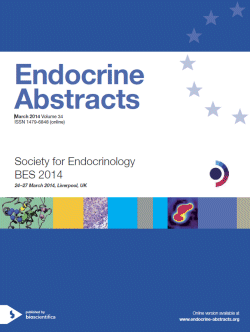Oral Communications
Steroids
ea0034oc3.1 | Steroids | SFEBES2014
Lack of 11β-hydroxysteroid dehydrogenase type 1 ameliorates the adverse features of Cushing's syndrome
Morgan Stuart , McCabe Emma , Gathercole Laura , Hassan-Smith Zaki , Larner Dean , Bujalska Iwona , Stewart Paul , Tominson Jeremy , Lavery Gareth
ea0034oc3.2 | Steroids | SFEBES2014
5α-reductase is a regulator of glucocorticoid action and metabolic phenotype in human liver
Nasiri Maryam , Nikolaou Nikolaos , Parajes Silvia , Bujalska Iwona , Gathercole Laura , Tomlinson Jeremy
ea0034oc3.3 | Steroids | SFEBES2014
The 21-hydroxylase pseudogene may have a role in induction of tolerance to steroidogenic machinery
Mitchell Anna Louise , Bronstad Ingeborg , Wolff Anette Boe , Narravula Alekhya , Skinningsrud Beate , Husebye Eystein S , Pearce Simon H S
ea0034oc3.4 | Steroids | SFEBES2014
Pre-receptor glucocorticoid metabolism across human ageing: the impact of gender and menopausal status
Hassan-Smith Zaki , Morgan Stuart , Sherlock Mark , Hughes Beverly , Lavery Gareth , Tomlinson Jeremy , Stewart Paul
ea0034oc3.5 | Steroids | SFEBES2014
Linking GWAS to gene function: CYP17A1 in hypertension
Diver Louise , MacKenzie Scott , McManus Frances , Freel Marie , Friel Elaine , Fraser Robert , Hanley Neil , Connell John , Davies Eleanor
ea0034oc3.6 | Steroids | SFEBES2014
Targeting of lysyl oxidase by steroids to reduce peritoneal fibrosis and scarring
Harlow Christopher , Wu Xuan , van Deemter Marielle , Gardiner Fiona , Poloand Craig , Green Rebecca , Sarvi Sana , Kadler Karl , Lu Yinhui , Mason J Ian , Critchley Hilary , Hillier Stephen




